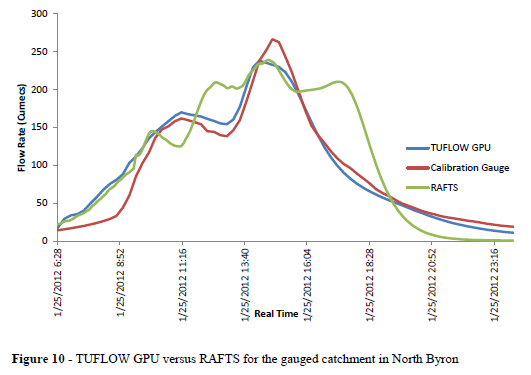TUFLOW Benchmarking: Difference between revisions
Chris Huxley (talk | contribs) |
Chris Huxley (talk | contribs) |
||
| Line 36: | Line 36: | ||
*[http://www.tuflow.com/Download/Publications/2012Boyte_DirectRainfallValidation.pdf Click Here For Thesis Link (Boyte, 2014)] |
*[http://www.tuflow.com/Download/Publications/2012Boyte_DirectRainfallValidation.pdf Click Here For Thesis Link (Boyte, 2014)] |
||
<br> |
|||
= Independent Benchmark Testing = |
= Independent Benchmark Testing = |
||
Revision as of 06:41, 23 September 2015
Developer Benchmark Testing
University Thesis (Syme, 1991)
University Thesis (Barton, 2001)
University Thesis (Huxley, 2004)
This thesis validates TUFLOW against independent analytical calculations. The study used over 300 benchmark models to verify the accuracy of TUFLOW for a range of flow conditions (super critical, critical and subcritical). The specific test cases included:
- 1D culvert flow;
- 1D weir flow;
- 2D weir flow;
- 2D channel flow;
- 2D floodplain flow; and
- 2D channel/floodplain flow.
The TUFLOW results were found to be within a 2% accuracy of the analytical estimates in 97% of the benchmark models.
University Thesis (Caddis, 2010)
University Thesis (Boyte, 2014)
This thesis investigated incorporating hydrology into direct rainfall models, with consideration given to hydraulic resistance mechanisms at shallow flow. The direct rainfall methodology was implemented into a two dimensional shallow water model, TUFLOW GPU; which was compared against an industry standard hydrologic model, XP RAFTS.
The primary objectives were to determine whether TUFLOW GPU was a suitable software package to use in industry applications, whether the direct rainfall model was able to reproduce the hydrology of a real storm event in a gauged catchment more accurately than the hydrologic model; and to understand hydraulic resistance mechanisms at shallow flow and at different roughness scales. These objectives were met through numerical modelling with real data produced from experiments, stream gauges, or analytical solutions. Dressler’s sloping dam break analytical model was used to validate TUFLOW GPU, a gauged catchment in New South Wales was used to compare hydrology representation in the direct rainfall model and hydrologic model, and experimental data from an open channel at shallow flow was analysed to analyse hydraulic resistance mechanisms. Monte Carlo testing by simulating non uniformity in bed roughness was undertaken on an ungauged catchment in New South Wales to determine the practical impacts of secondary flows, which arose after analysis of the experimental data.
Independent Benchmark Testing
United Kingdom Environment Agency
The United Kingdom Environment Agency have documented independent testing of most 2D modeling packages. This is a good resource for comparing TUFLOW to other available software:
